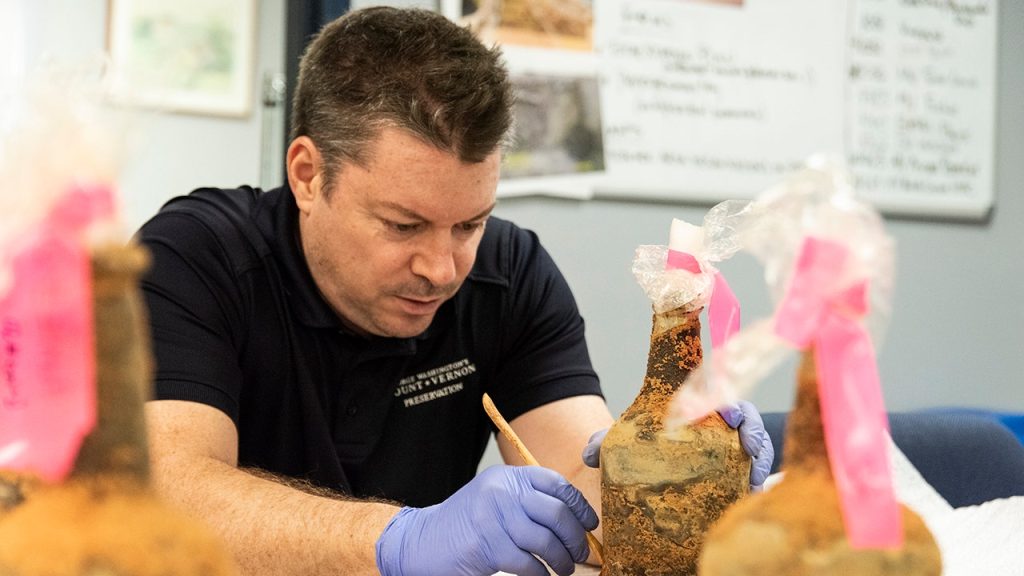Archaeologists at George Washington’s Mount Vernon have recently made a significant discovery in the historic Northern Virginia home, revealing dozens of glass jars filled with fruit preserves in the cellar that likely date back to before the American Revolution. This remarkable find includes 29 intact bottles containing cherries, gooseberries, or currants, shedding light on 18th-century food preservation methods. Mount Vernon President & CEO Doug Bradburn described the discovery as unprecedented, emphasizing its potential to provide insight into the origins of the United States as the nation approaches its 250th anniversary in 2026. The archaeological finds are undergoing scientific analysis in collaboration with the U.S. Department of Agriculture’s Agricultural Research Service.
The discovery of the glass bottles filled with fruit preserves follows a previous finding of two bottles containing a mysterious liquid, cherries, and pits believed to have been refrigerated between 1758 and 1776. The newly discovered jars have been carefully extracted from storage pits in the cellar of the home and are currently being refrigerated at the archeology lab for preservation. The artifacts contain cherry pits and stems, indicating that they were likely filled with cherries before being sealed and buried. The delicate nature of these 18th-century artifacts necessitates meticulous care and conservation to further study their contents and historical significance.
The Mount Vernon research team tasked with managing the preservation and analysis of the ancient glass bottles notes that such intact food remains from the 18th century are rare and offer valuable insights into plantation foodways and American cuisine origins. The discovery showcases the knowledge and skill of the enslaved individuals who managed food preparations at Mount Vernon, including Doll, the cook brought to the estate by Martha Washington in 1759. Historical context suggests that burying preserves underground was a common practice in 18th-century Virginia to keep fruits and vegetables cool in the warm climate. The ongoing Mansion Revitalization Project at George Washington’s Mount Vernon will continue to support research and preservation efforts relating to these significant archaeological finds.
George Washington resided at Mount Vernon along the Potomac River from 1759 until his death in 1799, using the estate as a place of residence and a strategic center for agricultural and political activities. His tenure as the first president of the United States from 1789 to 1797 solidified his role as a key figure in American history. The recent discoveries of 18th-century glass bottles filled with preserved fruit add to the legacy of Mount Vernon as a site of historical importance and ongoing research. As the archaeological team and preservation experts at the home work to analyze and conserve the newfound artifacts, the public can expect further insights into Washington’s culinary practices and the daily lives of those who maintained his estate.
The excavation of the glass jars containing fruit preserves at Mount Vernon highlights the meticulous preservation efforts undertaken by the Mount Vernon Ladies’ Association, America’s first historic preservation organization. The delicate nature of the bottles, which have likely been untouched since before the American Revolution, underscores the significance of this find in shaping understandings of early American foodways and agricultural practices. The partnership with the U.S. Department of Agriculture’s Agricultural Research Service will facilitate in-depth analyses of the cherry pits, stems, and contents of the preserved jars, shedding light on the culinary traditions and environmental conditions of 18th-century America.
In conclusion, the recent discovery of intact glass jars filled with fruit preserves at George Washington’s Mount Vernon offers a rare glimpse into the past, showcasing the ingenuity of 18th-century food preservation methods and the contributions of enslaved individuals to plantation cuisine. The ongoing research and conservation efforts surrounding these artifacts demonstrate a commitment to understanding and preserving the historical significance of Mount Vernon and its role in shaping American history. As experts continue to study the contents of the glass jars and their implications for American culinary heritage, the legacy of George Washington and his estate remains a focal point in discussions of early American society and culture.













